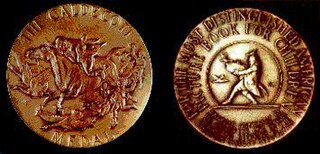
The Randolph Caldecott Medal, frequently shortened to just the Caldecott, annually recognizes the preceding year's "most distinguished American picture book for children". It is awarded to the illustrator by the Association for Library Service to Children (ALSC), a division of the American Library Association (ALA). The Caldecott and Newbery Medals are considered the most prestigious American children's book awards. Beside the Caldecott Medal, the committee awards a variable number of citations to runners-up they deem worthy, called the Caldecott Honor or Caldecott Honor Books.
Trina Schart Hyman was an American illustrator of children's books. She illustrated over 150 books, including fairy tales and Arthurian legends. She won the 1985 Caldecott Medal for U.S. picture book illustration, recognizing Saint George and the Dragon, retold by Margaret Hodges.

Where the Wild Things Are is a 1963 children's picture book written and illustrated by American writer and illustrator Maurice Sendak, originally published in hardcover by Harper & Row. The book has been adapted into other media several times, including an animated short film in 1973 ; a 1980 opera; and a live-action 2009 feature-film adaptation. The book had sold over 19 million copies worldwide as of 2009, with 10 million of those being in the United States.
Stephen Gammell is an American illustrator of children's books. He won the 1989 Caldecott Medal for U.S. picture book illustration, recognizing Song and Dance Man by Karen Ackerman. His illustrations in Where the Buffaloes Begin by Olaf Baker (1982) and The Relatives Came by Cynthia Rylant (1986) earned those titles the designation of Caldecott Honor books. Although he is most widely known for his evocative, nightmarish illustrations for Alvin Schwartz's Scary Stories to Tell in the Dark trilogy, he has illustrated nearly seventy books between 1973 and 2013, including nine which he authored himself.
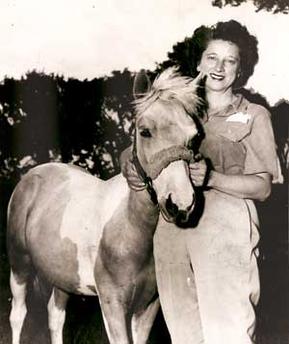
Marguerite Henry was an American writer of children's books, writing fifty-nine books based on true stories of horses and other animals. She won the Newbery Medal for King of the Wind, a 1948 book about horses, and she was a runner-up for two others. One of the latter, Misty of Chincoteague (1947), was the basis for several sequels and for the 1961 movie Misty.
Elizabeth Orton Jones was an American illustrator and writer of children's books. She won the 1945 Caldecott Medal for U.S. picture book illustration, recognizing Prayer for a Child, after being a runner-up one year earlier.
Native Americans have been featured in numerous works of children's literature. Some have been authored by non-Indigenous writers, while others have been written or contributed to by Indigenous authors.
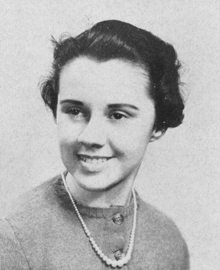
Marcia Joan Brown was an American writer and illustrator of more than 30 children's books. She has won three annual Caldecott Medals from the American Library Association, and six Caldecott Medal honors as an illustrator, recognizing the year's best U.S. picture book illustration, and the ALA's Laura Ingalls Wilder Medal in 1992 for her career contribution to children's literature. This total of nine books with awards and honors is more than any other Caldecott-nominated illustrator. Many of her titles have been published in translation, including Afrikaans, German, Japanese, Spanish and Xhosa-Bantu editions. Brown is known as one of the most honored illustrators in children's literature.

Paul Goble was a British-American writer and illustrator of children's books, especially Native American stories. His book The Girl Who Loved Wild Horses won a Caldecott Medal in 1979.
Barbara Cooney was an American writer and illustrator of 110 children's books, published over sixty years. She received two Caldecott Medals for her work on Chanticleer and the Fox (1958) and Ox-Cart Man (1979), and a National Book Award for Miss Rumphius (1982). Her books have been translated into 10 languages.
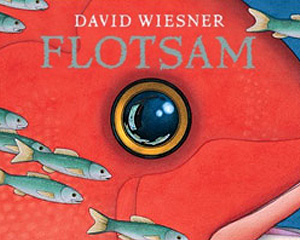
Flotsam is a children's wordless picture book written and illustrated by David Wiesner. Published by Clarion/Houghton Mifflin in 2006, it was the 2007 winner of the Caldecott Medal; the third win for David Wiesner. The book contains illustrations of underwater life with no text to accompany them.

Marla Frazee is an American author and illustrator of children's literature. She has won two Caldecott Honors for picture book illustration.

A Sick Day for Amos McGee is a 2010 children's picture book written by Philip C. Stead and was illustrated by Erin E. Stead. The book, published by Roaring Brook Press, depicts a zookeeper who has bonded with the animals he cares for and who come and visit him one day when he gets sick. Phillip Stead wrote the book hoping his wife Erin would illustrate it after a period where she had become discouraged with her art. The book was well reviewed, and Erin won the 2011 Caldecott Medal for her illustrations. The book received praise for its woodblock illustrations and for its message about what friends will do to help and support each other.

In the children's picture book Chanticleer and the Fox, Barbara Cooney adapted and illustrated the story of Chanticleer and the Fox as told in The Nun's Priest's Tale in Chaucer's Canterbury Tales, translated by Robert Mayer Lumiansky. Published by Crowell in 1958, it was the recipient of the Caldecott Medal for illustration in 1959. It was also one of the Horn Book "best books of the year".
Georgess McHargue was an American writer and poet.

Finding Winnie: The True Story of the World's Most Famous Bear is a 2015 children's book written by Canadian author Lindsay Mattick and illustrated by Sophie Blackall. The non-fiction book is framed as a story Mattick is telling to her son. Her great-grandfather, Harry Colebourn bought a bear on his way to fight in World War I, donating the bear to a zoo where it became the inspiration for the character of Winnie-the-Pooh. Finding Winnie was thoroughly researched by both Blackall and Mattick. The book's writing and illustrations were well reviewed and it won the 2016 Caldecott Medal.

Wolf in the Snow is a 2017 wordless picture book by Matthew Cordell. The book was favorably received by critics and won the 2018 Caldecott Award. The story has drawn comparisons to fairy tales like Little Red Riding Hood. The nearly wordless book tells the story of a girl and wolf who each get lost in the snowstorm. Cordell used distinctive illustration techniques for the girl and the wolf.

A Big Mooncake for Little Star is a 2018 picture book written and illustrated by Grace Lin. The story is about Little Star gradually eating the mooncake that her mother has baked. The book was a departure for Lin both thematically and in her use of illustrative style. The book was well reviewed and was awarded a Caldecott Honor. The illustrations feature heavy use of black and rely on both the pictures and words to convey the story and its themes.

Michaela Goade is an American illustrator. A member of the Tlingit and Haida tribes, she is known for her work on picture books about Indigenous people. She won the 2021 Caldecott Medal for her illustrations in We Are Water Protectors and is the first Indigenous artist to receive the award. Her book, Berry Song was a Caldecott Honor book in 2023.
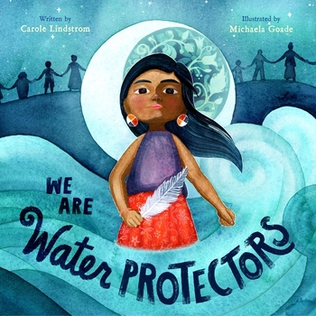
We Are Water Protectors is a 2020 picture book written by Carole Lindstrom and illustrated by Michaela Goade. Written in response to the Dakota Access Pipeline protests, the book tells the story of an Ojibwe girl who fights against an oil pipeline in an effort to protect the water supply of her people. It was published by Roaring Brook Press on March 17, 2020. The book was well received. Critics praised its message of environmental justice, its depiction of diversity, and the watercolor illustrations, for which Goade won the 2021 Caldecott Medal, becoming the first Indigenous recipient of the award. The book also received the 2021 Jane Addams Children's Book Award winner in the Books for Younger Children category.














